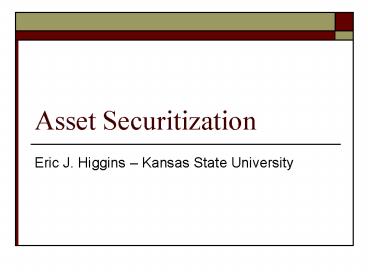Asset Securitization PowerPoint PPT Presentation
1 / 16
Title: Asset Securitization
1
Asset Securitization
- Eric J. Higgins Kansas State University
2
The Securitization Market
3
ABS Outstanding, 2002
Source Bond Market Association
4
What is Securitization?
- Transformation of an asset into an investment
- Selling claims on future cash flows
- Any asset with expected future cash flows can be
securitized - Mortgages, credit card receivables, song
portfolios - The essence of securitization is risk sharing
- Issuer transfers risk to investors
- Investors are willing to bear risk in exchange
for appropriate expected return
5
Benefits of Securitization
- Issuers get liquidity
- Allows issuers to create more assets
- Make more loans, issue more credit cards, etc.
- Investors get higher returns
- Get access to markets otherwise unavailable
- Allows for diversification as well as higher
returns
6
Risk in Asset Backed Securities
- Risks for investors in asset backed securities
- Interest rate risk -- Like any debt instrument,
the value of a ABS will vary with changes in
interest rates. - As interest rates increase, the value of the ABS
will go down, and vice-versa
7
Risk in Asset Backed Securities
- Risks for investors in asset backed securities
- Pre-payment risk
- Borrower may pay loans earlier. Causes return on
ABS to be lower than expected. Generally,
prepayment risk is higher when interest rates go
down. Opposite of interest rate risk - Estimating prepayments
- Constant prepayment
- Escalating prepayment
8
Risk in Asset Backed Securities
- Risks for investors in mortgage backed securities
- Default risk
- MBS is only as good as the issuer. FNMA and GNMA
MBSs are guaranteed. Many other asset backed
securities are not.
9
Risk in Asset Backed Securities
- Risks for issuers
- Warehousing of loans before securitization
- Lack of market for securitized product
- Lack of market for underlying asset
10
Typical Securitization Structure
- Sequential claims form the waterfall.
Senior
Sub 1
Sub 2
11
Typical Securitization Structure
- Sequential claims form the waterfall.
- Size of senior and subordinate classes may be
altered to affect repayment probability for
senior securities. - Underlying pieces are a form of credit
enhancement, or guarantee.
AAA
AAA
A
A
BBB
BBB
12
Typical Securitization Structure
- Cash leftover after distributions to investors
and funding of credit enhancements are called the
excess spread - Inadequate excess spread is a sign that the pool
is not producing expected cash payments - Excess spread has direct relationship with value
- Higher the excess spread (from zero) ?
- Greater certainty that payments will be made ?
- Lower default risk ?
- Greater value
13
ABS Downgrades
- Moodys, SP, and Fitch ratings changes show
downgrades are rare for credit card ABS
14
True Sale Provision
- True sale governed by FASB 140
- Governs sale of loans from originator to SPE
- Reiterated in supervisory treatment
Borrower
Loan Originator
Special Purpose Entity
Rating Agency
Credit Enhancer
Underwriter
Investors
15
Types of Support Provided
- Adding higher quality (or discounted) receivables
- Removing early amortization triggers
- Increasing credit enhancement
- Lowering base rate
- Recently done by Chase (April 28, 2003)
16
Implications
- True sale is fiction but
- Sponsor is rewarded for providing support though
may require time to put affairs in order before
next issuance. - Sponsor may be acting rationally by violating
GAAP/RAP. - Could behavior be harmful to safety net?
- Points out the need to think harder about how
securitization affects firms and how to establish
meaningful capital requirements for securitizing
banks.

